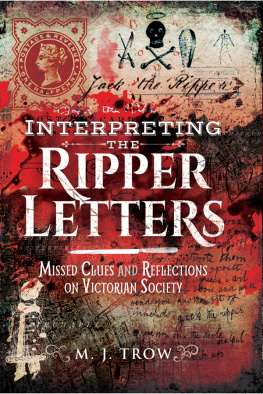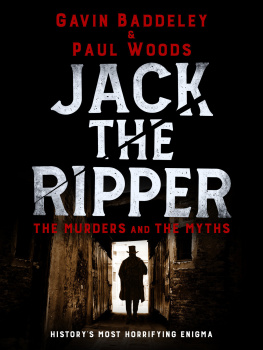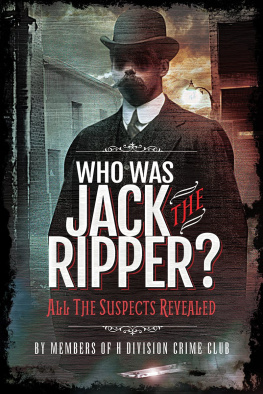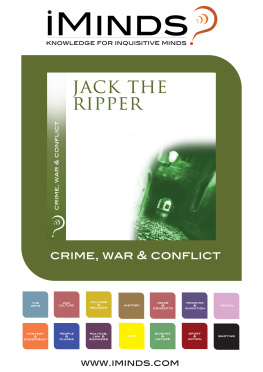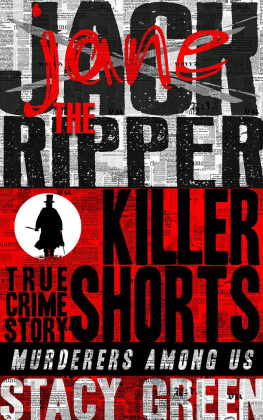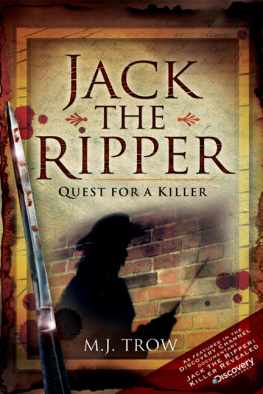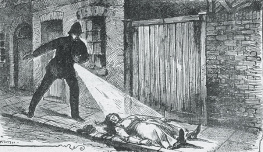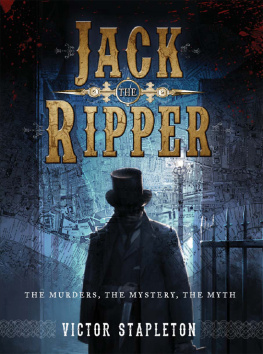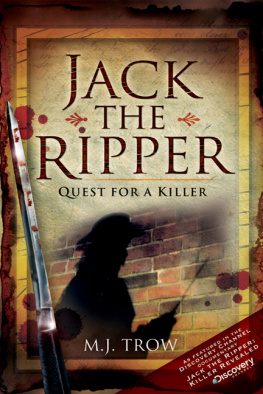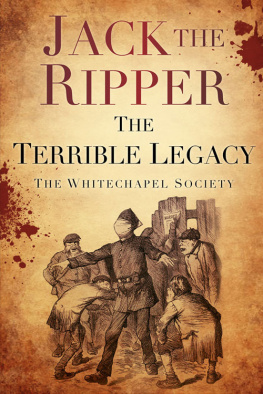Pagebreaks of the print version

Interpreting the Ripper Letters
Interpreting the Ripper Letters
Missed Clues and Reflections on Victorian Society
M. J. Trow

First published in Great Britain in 2019 by
Pen & Sword True Crime
An imprint of
Pen & Sword Books Ltd
Yorkshire Philadelphia
Copyright M. J. Trow, 2019
ISBN 978 1 52673 929 2
eISBN 978 1 52673 930 8
Mobi ISBN 978 1 52673 931 5
The right of M. J. Trow to be identified as Author of this work has been asserted
by him in accordance with the Copyright, Designs and Patents Act 1988.
A CIP catalogue record for this book is available from the British Library.
All rights reserved. No part of this book may be reproduced or transmitted in any
form or by any means, electronic or mechanical including photocopying, recording
or by any information storage and retrieval system, without permission from the
Publisher in writing.
Pen & Sword Books Ltd incorporates the Imprints of Pen & Sword Books
Archaeology, Atlas, Aviation, Battleground, Discovery, Family History, History,
Maritime, Military, Naval, Politics, Railways, Select, Transport, True Crime,
Fiction, Frontline Books, Leo Cooper, Praetorian Press, Seaforth Publishing,
Wharncliffe and White Owl.
For a complete list of Pen & Sword titles please contact
PEN & SWORD BOOKS LIMITED
47 Church Street, Barnsley, South Yorkshire, S70 2AS, England
E-mail:
Website: www.pen-and-sword.co.uk
or
PEN AND SWORD BOOKS
1950 Lawrence Rd, Havertown, PA 19083, USA
E-mail:
Website: www.penandswordbooks.com
Acknowledgements
M y thanks to all who have contributed ideas and suggestions for this book, from the disturbed and peculiar in Victorian society to todays earnest researchers who doggedly search for the worlds best-known Unknown Subject.
My thanks also go to Heather Williams and her team at Pen and Sword; a pleasure to work with, as always.
Most especially, a special thank you to my wife, Carol, who not only typed out the manuscript but literally kept me alive to write the book at all.
Foreword
Ripper Buyer Beware!
A s I put the finishing touches to this book, a Ripper postcard has fetched 22,000 at Grand Auctions Ltd, of Folkestone. It was put up for sale by the widow of an ex-Metropolitan police officer, who was given the postcard when he retired in 1966. This is precisely the problem with Ripper literature and the reason why so many letters are missing. The Met had no right to give away archive material to anybody. Such artefacts should be in the public domain, not private hands.
For the record, the card is addressed To the High St Ealing Police Station Sergent and it reads, Beware there is two women I want here they are bastards. and I mean to have them my knife is still in good order [the card is date-stamped 29 October 1888] it is a students knife and I hope you liked the half of kidney. I am Jack the Ripper.
The uneven handwriting and the smudges look authentic, so does the card itself, complete with lilac halfpenny stamp and postmark. But the wording itself is suspect. I have come across only one other mention of bastards in the Ripper correspondence. The comment on the knife, the phrase I mean to have them is straight out of the 1896 letter which forms the last surviving missive in the record. The reference to half of kidney and the inference that students were involved is the result of a careful reading of the Lusk Letter controversy (see ).
I hope the card is genuine and that the winning bidder feels his huge outlay is justified. Sadly, I do not believe it is. Welcome to the topsy-turvy world of Ripperology.
Chapter One
Jacks Funny Little Games
T he adjacent parishes of Whitechapel and Spitalfields in Londons East End reached a kind of immortality because of what happened there in a four-month period in 1888; later called the autumn of terror.
At the time, the area was known as the Abyss and the Ghetto, a crimeridden sink of poverty and corruption made all the more alien to Victorian polite society by the recent arrival of Ashkenazi Jews, driven from their Russian and Polish homelands by Tsarist pogroms. Writers like Israel Zangwill and, slightly later, Jack London, paint vivid word pictures of the teeming life in the Abyss where nearly half a million people struggled to survive.
The two great social evils of the period, drunkenness and prostitution, fused in the labyrinth of streets and alleyways, slippery with scum and forever, it seemed, shrouded in night. All of the victims of the man the press called Jack the Ripper were prostitutes. All of them were regulars in pubs and off-licences; at least two of them were probably alcoholics. Despite the fact that prostitution was illegal and that various governments had tried to limit the availability of liquor, the problems continued unabated. Charitable organizations tried their best. General Booths girls of the Salvation Army went out from Angel Alley with soup, tambourines and an uplifting biblical verse. Thomas Barnardo opened up his homes for destitute children, left by profligate, useless parents to fend for themselves. The Reverend Samuel Barnett saved souls and lives from his headquarters at Toynbee Hall. But all this good work barely caused a dent in the vicious spiral of East End life. The police, undermanned and undervalued, turned a blind eye except when routine raids on brothels and places of assignation were among the orders of the day, usually prompted by middle-class sanctimonious pressure via the newspapers.
Violence was commonplace. So one is forced to conclude, Jack London wrote in The People of the Abyss in 1903, that the Abyss is literally a huge man-killing machine. The American writer cited a grim example he had come across; a man who had been out of work for eighteen months woke up one September morning and used his pocket-knife to cut the throat of his wife, Hannah, aged 33. Then he systematically slaughtered his four children in the same way: Frank, 12; Walter, 8; Nellie, 4; and Ernest, 16 months. Then he quietly waited with their bodies until the police came for him.
Edwin Pugh wrote of the Ghettos young, Children are begotten in drunkenness, saturated in drink before they draw their first breath, born to the smell and taste of it. He wondered particularly about the girls, for though she plays, the poor little girl of the London streets is never quite a child.
Jack London described the finding of a body by the police in a doorway in Dorset Street, regarded by some as the worst street in London. Homeless, shelterless, sick, with no one with her in her last hour, she had died in the night of exposure she died as a wild animal dies.
The men of the Abyss, London noted, fuelled by alcohol, readily resorted to violence:
They become indecent and bestial. When they kill, they kill with their hands They gouge a mate with a dull knife They wear remarkable boots of brass and iron and when they have polished off the mother of their children with a black eye they knock her down and proceed to trample her.
Nicholas Charrington, heir to the brewing family, saw just such an incident outside one of his fathers pubs. On the spot, he turned his back on his inheritance and formed a one-man crusade to combat the effects of demon drink, getting beaten up for his pains on more than one occasion.

